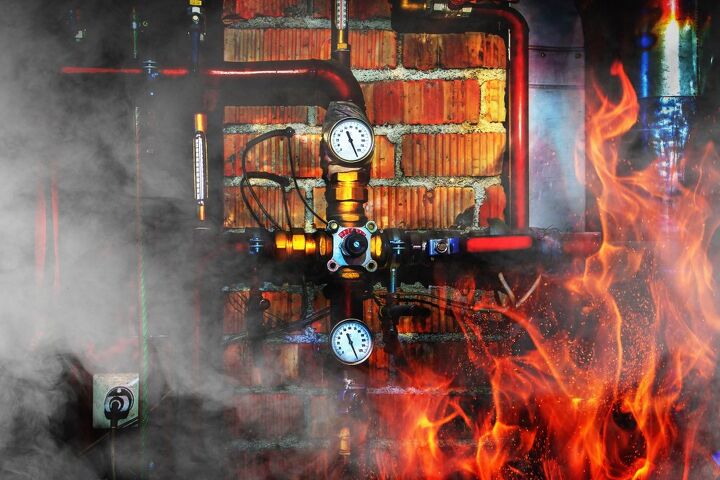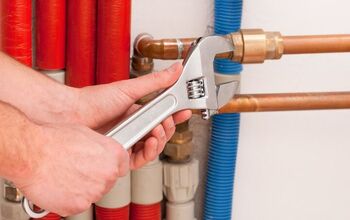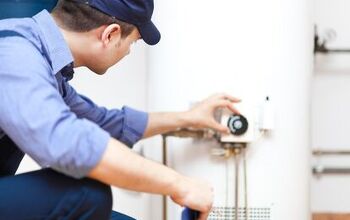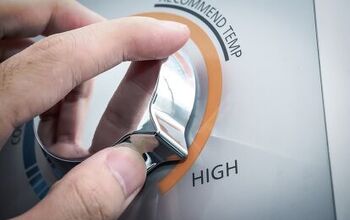Why Is My Water Heater Overheating? (Possible Causes & Fixes)

If the water from your faucet is too hot, this is not only uncomfortable but also unsafe. Extremely hot water is dangerous for all members of the family, especially if you have kids. Therefore, address this problem quickly to prevent further damage as the water heater could leak or burst.
If your water heater is overheating, you likely have the temperature set too high. In this case, you should turn down the temperature. Ideally, the standard setting for a water heater is 120 degrees Fahrenheit.
Do You Need Water Heater Repair Services?
Get free, zero-commitment quotes from pro contractors near you.

Reasons Why The Water Heater Is Overheating
If your water heater is overheating, there are several causes and solutions. Read below as we take you through the causes so that you can figure out what you particular situation is and how to fix it.
Temperature Setting
Water heaters have dial thermostats that allow you to control the temperature of the hot water. Typically, you should set the thermostat between 90 to 120 degrees Fahrenheit. But, if you set the dial too high, it can cause the water heater to overheat.
The thermostat will be in different places based on the type of water heater you have. Electric water heaters have upper and lower thermostats that you should set to the same temperature. If adjusting the thermostat doesn’t change the water temperature, you will need to replace it.
A gas water heater is controlled by a gas valve that has a dial to adjust the temperature. The valve also has a probe that monitors the water temperature. If adjusting the dial does not change your water heater to the desired temperature, you should replace the valve.
Sediment Buildup
Water consists of a lot of sediment and minerals. Usually, the water purification process filters out most of these minerals, but not all. Therefore, these leftover minerals can sink to the bottom of the water heater and cause buildup around the heating element.
Gas water heaters will not work as efficiently if there is sediment in the bottom of the tank. The sediment will cause heat to take longer to transfer to the water. When this happens, it can lead to the water heater elements overheating and causing overly hot water.
Blocked Pressure Relief Valve
The pressure relief valve allows built up steam to escape from the water heater. If this valve is blocked, the water can become hotter than usual. This can lead to a damaged water heater tank and injury to family members.
A common sign of a blocked pressure relief valve is boiling water inside of the tank. If your water is boiling from inside of the tank, immediately turn off the water heater. Call a professional as soon as possible as the water heater could explode.
Faulty Thermostat
If your water heater suddenly becomes hot, a faulty thermostat could be the reason for this. The thermostat controls the on and off cycles of the water heater. If the thermostat malfunctions, a safety feature triggers the thermostat to shut off power to the boiler elements.
If the thermostat safety feature fails, the elements will continue to heat the water. Unfortunately, this can lead to unsafe water temperatures. If this happens to your thermostat, you can easily replace it.
How To Replace A Water Heater Thermostat
Electric water heaters and gas water heaters use different types of thermostat systems. Gas water heaters have a gas control valve that includes a thermostat and a heating device. If the thermostat on a gas water heater goes out, you will have to replace the gas control valve.
However, if the heating element on an electric water heater remains on too long, it can overheat. You should replace this thermostat. Before you replace your electric water heater thermostat, test it to ensure it is not working properly.
How Do You Test A Thermostat?
To perform the test on your electric water heater thermostat, mark the current temperature setting with a marker. Then, turn down the temperature on the thermostat.
After a few hours, check the faucet’s water temperature, and if it hasn’t cooled, the thermostat has failed. Replacing the thermostat on an electric water heater is easier than a gas water heater. First, be sure that the new thermostat is the same as the old thermostat.
Tools And Materials
- Screwdrivers
- Non-contact voltage tester
- New thermostat
- Camera or phone that takes pictures
Note: You do not have to drain an electric water heater to replace the thermostat.
Step 1: Power Off The Thermostat
To begin replacing your water heater, turn off the breaker to the water heater circuit in the breaker box.
Step 2: Locate The Thermostat
To locate the thermostat, remove the metal cover over the thermostat compartment on the water heater tank. In some cases, you may need to remove screws to remove the panel. Remove the insulation behind the cover but be careful not to touch any wiring.
Step 3: Test The Thermostat For Power
Test that the thermostat power is off by testing all of the wires and screw terminals inside the thermostat compartment. To do this, use a non-contact voltage tester. The reading should show that there is no voltage present.
Step 4: Remove The Broken Thermostat
Before removing the broken thermostat, take a photo of the wire connections. You want to be sure that when reinstalling the new thermostat that the wires are right.
To remove the broken thermostat, loosen the two screw terminals using a screwdriver. Next, pull each wire from its terminal and remove the thermostat from the clips. Take the old thermostat out of the compartment but do not bend the clips as they could be unrepairable.
Step 5: Install The New Thermostat
To install the new thermostat, push it into the retaining clips. For best results, the thermostat should be flush against the wall of the water tank. Connect the two circuit wires to the thermostat’s appropriate screw terminals, matching the wires to the original thermostat.
Tighten the screws with a screwdriver and set the temperature to the desired setting using a flat blade screwdriver. The recommended setting is 120 degrees Fahrenheit for safety and energy efficiency.
Reinstall the metal cover and restore power to the circuit by switching on the circuit breaker. Next, give the water heater two hours to heat up. Afterward, test the water at the faucet to confirm that it is the correct temperature.
What Are Some Other Common Water Heater Issues?
In addition to your water heater overheating, water heaters can face other common issues, as well.
Water Is Not Hot Enough
If you are struggling with your water not being hot enough, check the thermostat. If it is set below 120 degrees Fahrenheit, adjust the temperature in small increments to avoid producing scalding water. It’s best not to adjust the temperature above 130 degrees Fahrenheit.
If you are using all of the hot water, consider replacing the water heater with a larger capacity model. For example, a 50-gallon water heater typically supplies enough hot water for a family of four to use.
Hot Water Has An Odor
Sometimes water conditions can cause a reaction between the anode rod and water. Consequently, this will result in hydrogen sulfide gas dissolving in the tank water. As a result, the gas becomes present in hot tap water, causing a rotten egg smell.
To solve this, install a less-reactive aluminum alloy anode rod. Or, you can also chlorinate the water supply system to eliminate any odor in the hot water.
There Is No Hot Water
If you have an electric water heater and there is no hot water, reset both circuit breakers by turning them off and on. Likewise, if you have a gas water heater, reset the circuit breaker the same way by turning it off and on.
If your electric water heater doesn’t heat after resetting the circuit breakers, turn the breakers off. Next, press the reset button for the high-temperature limit switch on the upper thermostat of the water heater. If the water begins to heat but then fails again, you most likely need to replace the thermostat.
If you have a gas water heater, ensure that you have enough gas provided to the water heater. Also, check the gas supply shut-off valve to make sure it’s open. Additionally, if your gas water heater uses a pilot light to ignite, relight the pilot light.
If the pilot light won’t stay lit after releasing the pilot button, replace the pilot’s thermocouple. Also, replace the thermostat if it doesn’t turn on the burner. If basic troubleshooting does not resolve the water heating issue, contact a maintenance specialist to examine the water heater.
Different Types Of Water Heaters
The two most common water heaters are gas and electric. They both heat water; the simple difference is how they heat the water.
Gas Water Heater
Gas water heaters use a burner to heat the water in the tank. You can find the burner inside the center of the water heater. The burner heats the water to the temperature set on the thermostat, then shuts off when it reaches that temperature.
Gas water heaters need a tank, combustion, and airflow to operate effectively. Gas water heaters transfer heat to water by combustion of natural gas or liquid propane. Because this is gas, these water heaters require airflow to remove any carbon monoxide from the home.
Electric Water Heater
Conversely, electric water heaters differ from gas water heaters in the apparent sense that they use electricity. These water heaters are also typically more efficient, although this can vary based on the specific model.
Electric water heaters use a heating element in the water that’s triggered when the temperature falls below the set level.
Electric water heaters heat water by passing electricity through resistant material. The electricity is turned to heat, which heats the water.
Do You Need Water Heater Repair Services?
Get free, zero-commitment quotes from pro contractors near you.

Related Questions
How often should I flush out my water heater?
Sediment can build up inside the water heater. To remove the sediment, flush and drain the water heater at least once a year. If you live in an area with hard water, drain and flush your water heater every six months.When you are done flushing and draining, the water should run clear. This process will take two to four hours. Although it is time-consuming, it can significantly prolong the life of your water heater.
When should I replace my water heater?
The expected lifespan of a conventional water heater is eight to 10 years. A tankless water heater has a lifespan of about 20 years. If your water heater is requiring more repairs, it may be time for a replacement. When you are ready to purchase a water heater, look for one that is energy efficient. It should be correctly sized to fit your family. Make sure that you research all of your options before deciding on a water heater.

Stacy Randall is a wife, mother, and freelance writer from NOLA that has always had a love for DIY projects, home organization, and making spaces beautiful. Together with her husband, she has been spending the last several years lovingly renovating her grandparent's former home, making it their own and learning a lot about life along the way.
More by Stacy Randall



























